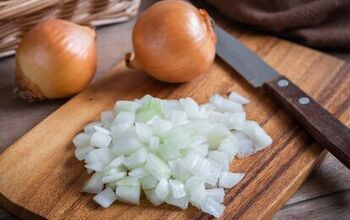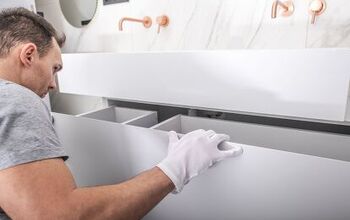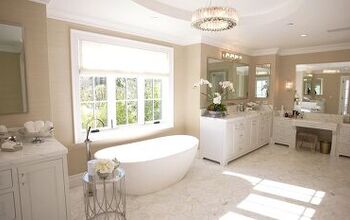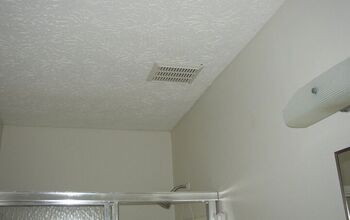Should The Bathroom Vanity Be Against The Wall? (Find Out Now!)

Bathroom vanities have evolved over the years from a simple cabinet and countertop design to sophisticated masterpieces. Homeowners and designers now use antiques and other repurposed furniture for bathroom vanities. The creativity is a welcome change, but it does come with some downsides, such as proper positioning of the vanity and plumbing.
Yes. Ideally, the bathroom vanity should be against the wall. It makes your bathroom look finished, hides the plumbing, and allows easy access to the drains and pipes. Cover the gaps with the same material as the vanity. Another option is to re-cut the countertop or reroute the plumbing and move the vanity against the wall.
Let’s take a look at why the bathroom vanity needs to be against the wall and ways to fix any gaps between the vanity and walls.
Do You Need to Hire Cabinet Installers?
Get free, zero-commitment quotes from pro contractors near you.

Why the Bathroom Vanity is Against the Wall
A bathroom vanity needs to be against the wall for aesthetic and practical reasons. Your bathroom looks unfinished if there is a gap between the vanity and wall. It also leaves the plumbing exposed. On the practical side, plumbing is installed for the vanity to be against the wall. The placement also allows plumbers to easily access the pipes and drains for repairs.
How to Fix a Bathroom Vanity That is Not Against the Wall
There are three ways to fix a vanity that is not against the back or side wall.
Fill in the Gap
The easiest and most affordable way to fix a vanity that is not against the wall is to cover the gap. Use the same material and finish as your vanity. Cut the material to the width and height of the gap, and attach it to the sides of the vanity, not the wall. Use a second piece of the material, such as a backsplash, to cover the gap between the countertop, back wall, and side walls.
Move the Vanity
Moving the vanity is a more intensive and expensive job. First, determine why the vanity is not against the wall. Was the opening for the sink not centered on the countertop? Is the plumbing design wrong?
Sink Opening Not CenteredIf the vanity was installed away from the wall because the hole for the sink was not cut properly, replace the vanity countertop. The new position of the sink opening should allow for the vanity to be pushed against the wall without moving the plumbing.
Poor Plumbing DesignAs people get more creative with their vanity designs, plumbers have learned to modify installations to accommodate the drains and pipes. The standard plumbing design of your house may not work well with your new non-standard vanity. Contact a professional plumber to have the pipes and drain moved.
How to Fix an Uneven Gap Between the Vanity and Wall
An uneven gap between the vanity and wall indicates that the opening for the sink is crooked. If you have a circular drop-in or undermount sink, detach it from the countertop. Disconnect the plumbing. When you remove the sink, check under the cabinet for any brackets holding the basin in place. Straighten the vanity, and reattach the sink and plumbing. This also works with vessel sinks that use circular openings.
For other sink styles and shapes, replace the countertop and move the vanity against the wall.
How to Install a Vanity with Legs Against the Wall
A vanity with legs, such as a repurposed antique cabinet, looks best when it is set away from side walls. Leave about 1” to 2” on either side. If the vanity is next to the toilet, the center of the sink needs to be 30” from the center of the toilet bowl. Push the vanity as close to the back wall as possible. Install a backsplash for a finished look.
Related Questions
How do I install a vessel sink?
If you want to install a vessel sink in your existing vanity, replace the countertop. Small circular holes are cut into the countertop for the base of the vessel sink and plumbing. Seal the bottom of the vessel sink with caulk.
Can I use my sink in a new vanity?
Yes. Buy a vanity that is sized for your bathroom, and have the opening in the countertop cut to fit your existing sink.
How do I add a second sink to my vanity?
Yes, as long as the countertop is large enough for a double vanity. Replace the countertop to fit two sinks. Contact a plumber to have additional drains, faucets, and plumbing installed.
Do You Need to Hire Cabinet Installers?
Get free, zero-commitment quotes from pro contractors near you.

Summary
Bathroom vanities should be against the wall to accommodate the plumbing and give your bathroom a finished look. The exception is a vanity with legs. These pieces look best with 1” to 2” on either side. If the vanity is next to your toilet, building codes define the spacing between the two fixtures. Make sure that the center of the sink basin is at least 30” from the center of the toilet bowl.
A quick fix for a vanity that is not against the wall is to cover the gaps with the same material as your vanity. Use a backsplash for the space between the countertop and back wall.
A gap between the vanity and wall may indicate that the plumbing does not line up with the sink drain and faucet. The plumbing pipes may be too long. If you want to move your vanity against the wall, reroute the drains, faucet inlets, and pipes.
If there is an uneven gap between the vanity and wall, turning the vanity fixes the problem. This is fairly simple with circular sink openings. Detach the sink and plumbing, straighten the vanity, and reattach the sink and plumbing. Other sink styles and shapes require that the countertop opening be recut. After the new countertop is installed, remove the caulk from around the vanity, as well as any screws holding it in place. Straighten the vanity, reattach to the wall with screws, and apply new caulk around the edges.

Jennifer L. Eggerton loves being hands-on, whether it's with a home DIY project, making repairs, re-decorating a room, or keeping life organized. She enjoys helping people by sharing her knowledge, insights, and experiences, as well as her lessons learned. In addition to her work as a writer, Jennifer is a Jeep® overlander, self-published author, and nature photographer who loves being outdoors.
More by Jennifer Eggerton



























